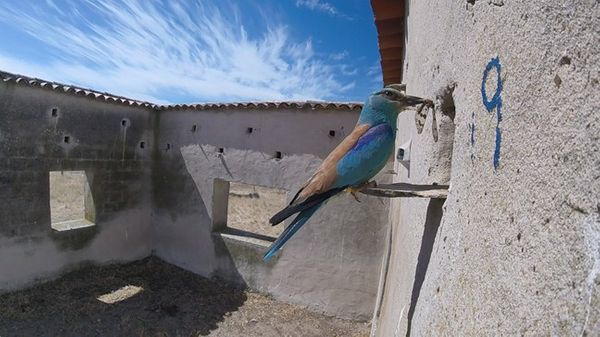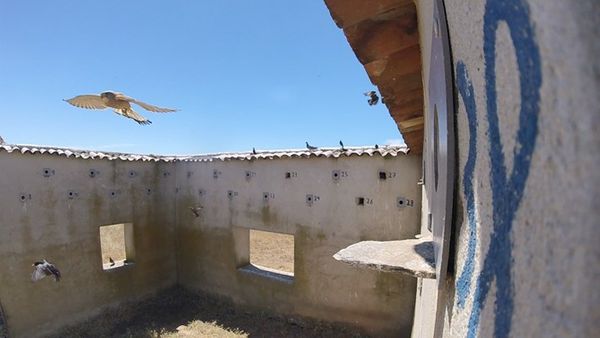 LINKED PAPER
LINKED PAPER
High trophic niche overlap in mixed-species colonies using artificial nests. Gameiro, J., Catry, T., Marcelino, J., Franco, A.M.A., Palmeirim, J.M. & Catry, I. 2022 Ibis. doi: 10.1111/ibi.13059 VIEW
While widely used in conservation, artificial nests may modify species interactions and trophic dynamics that have been overlooked by researchers and conservation managers. Our new study, now published in Ibis, investigates the dietary trophic overlap in mixed-species colonies established in artificial nests.
Artificial nests are widely used in conservation to increase the number of individuals of a given species. While wooden nest-boxes for birds are the classical example, many different types of artificial nests are used for many different taxa, from reptiles to marsupials, from insect hotels to large breeding walls with several dozens of cavities for birds (Fig. 1).

Figure 1 European Roller (Coracias garrulus) with food using an artificial colony © João Gameiro.
Compelling evidence has been found regarding the success of artificial nests at restoring the population of many species; yet they may attract non target species, which may alter the structure of communities and modify species interactions, ultimately affecting the effectiveness of the conservation for the target species. We know very little about the impacts of nest provisioning on the structure and functioning of bird communities, particularly when artificial nests are provided at high densities.
In southern Portugal, Liga para a Proteção da Natureza (which is funded by the LIFE-European programme) conduct a large-scale nest site provisioning scheme, aimed at recovering the endangered Lesser Kestrel (Falco naumanni). The Lesser Kestrel is a small colonial falcon that nests on pre-existing cavities. Several breeding walls and towers with up to 90 cavities each were erected in the Castro Verde Special Protection Area. In this treeless landscape, artificial nests attracted several other bird species including: Common Kestrels (Falco tinnunculus), European Rollers (Coracias garrulus), Barn Owls (Tyto alba), Little Owls (Athene noctua), and Spotless Starlings (Sturnus unicolor) (Fig. 2). Most of these species prey on arthropods and small vertebrates, which may lead to high levels of interspecific competition within these high-density colonies.

Figure 2 Several species (Lesser Kestrels Falco naumanni, Spotted Starlings Sturnus unicolor and pigeons Columba spp.) using an artificial colony, however, not with food © João Gameiro.
We used stable isotope analysis (δ15N and δ13C) to assess inter- and intraspecific dietary segregation within these species assemblages and investigated the mechanisms allowing species coexistence.
We collected any type of tissue from the bird, like feathers or blood, which can tell us what the bird is eating. Then, we compared the signature of the isotope ratios of carbon and nitrogen elements to those of the main prey we collected from the birds’ nest. This allowed us to create ellipses of the trophic niche of each bird species, and to quantify the overlap between the ellipse of two species, and the mean overlap of the community.
As a team, we collected feathers from 148 nestlings of six species to evaluate interspecific overlap, and blood-plasma from 38 parent-offspring pairs to evaluate parent-offspring diet segregation. Each tissue type reflects the diet of the bird during different periods, depending on the time it takes to form the tissue.
Our results suggest that there is a clear segregation between parents and offspring in all species. Parent birds eat different prey than they give to their nestlings, which may an adaptation to reduce competition within species.
However, we also found a relatively high overlap among species, especially between Lesser Kestrels, European Rollers and Spotted Starlings. This suggests that they feed on similar prey, which could lead to high levels of interspecific competition. Therefore, this may hinder the success of conservation actions toward endangered species.

Figure 3 Overlap in isotopic niches among nestlings from six bird species breeding in mixed colonies, established in an artificial breeding landscape, Southern Portugal. Species: Yellow = Barn Owl, green = Little Owl, red = Common Kestrel, orange = Lesser Kestrel, blue = European Roller and black = Spotted Starling.
Within the Castro Verde SPA, there is high quality habitat with high availability of prey like grasshoppers and other invertebrates. Such an abundance of high-quality habitat and prey availability may prevent competition and allow these species to coexist. However, we do not know if this high overlap will occur in lower quality areas and areas with reduced prey availability, which are predicted to increase with ongoing human and climate mediated changes to the environment.
Our study highlights that conservation actions need to consider non-target species and how they interact with target species and the long-term effects on conservation.
Image credit
Top right: European Roller (Coracias garrulus) © Zeynel Cebeci CC BY-SA 4.0 Wikimedia Commons.
If you want to write about your research in #theBOUblog, then please see here.



